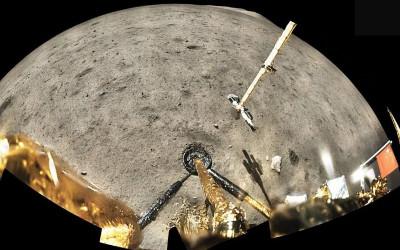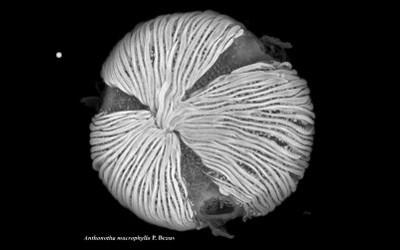New potential water resources for lunar exploration

Research supported by an OU academic, has found that glass beads formed from the cooling of melted material ejected by and found strewn across the Moon could store substantial quantities of water.
These findings, published in Nature Geoscience, were a result of analyses of samples from China’s Chang’e-5 mission (one of the lander legs and the robotic arm that collected the soil sample, analysed in this work, shown in the image to the right). It suggests that lunar soils contain a higher amount of water derived from solar wind (the flow of charged particles from the sun) than previously thought.
Mahesh Anand, Professor of Planetary Science and Explorations at the OU was a co-author of the study. His specific involvement, which was funded by the UK Science and Technology Facilities Council (STFC), was to help interpret the data on the lunar impact glass beads and provide scientific context based on his team’s previous research on lunar samples.
Professor Anand highlighted the significance of the findings:
“This work is an important advancement in our understanding of the abundance, source, and storage of water at the lunar surface. In this work, lunar impact glass beads collected by China’s Chang’e-5 mission were studied. The results suggest that the lunar soils contain a much higher amount of solar-wind-derived water than previously thought.
“Furthermore, this solar-wind-derived water appears to diffuse in and out of the glass beads over a time scale of a few years, confirming an active water cycle at the Moon. This would be of significant interest for creating resources during lunar expeditions using materials found on the Moon, known as in situ resource utilization (ISRU).”
The authors suggest that the water trapped in impact glass beads could represent a potential water resource for future lunar exploration that is relatively easy to extract. They conclude that impact glass may host similar water reservoirs on other airless bodies.
A version of this story, written by Laura Bandell, originally appeared on OU News.
Contact our news team
For all out of hours enquiries, please telephone +44 (0)7901 515891
Contact detailsNews & articles

Unlocking the secrets of pollen: OU’s role in a groundbreaking international digitisation project
In a transformative leap for the century-old science of palynology - the study of pollen - The Open University is helping in/contributing to a global effort to digitise and preserve one of the world’s most important botanical collections.